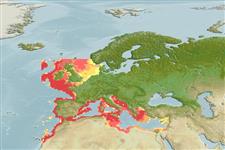Teleostei (teleosts) >
Pleuronectiformes (Flatfishes) >
Scophthalmidae (Turbots)
Etymology: Lepidorhombus: Greek, lepis = scale + Greek, rhombos = paralelogram (Ref. 45335).
Eponymy: Louis-Augustin Guillaume Bosc d’Antic (1759–1828) was a French naturalist and botanist. [...] (Ref. 128868), visit book page.
More on author: Risso.
Environment: milieu / climate zone / depth range / distribution range
Ecology
Marine; demersal; depth range 7 - 800 m (Ref. 6501). Temperate; 70°N - 26°N, 15°W - 36°E
Northeast Atlantic: British Isles south to Cape Bojador, West Sahara and the Mediterranean.
Length at first maturity / Size / Weight / Age
Maturity: Lm ? range ? - ? cm
Max length : 40.0 cm SL male/unsexed; (Ref. 4703); common length : 20.0 cm TL male/unsexed; (Ref. 3397); max. published weight: 640.00 g (Ref. 86713)
Dorsal spines (total): 0; Dorsal soft rays (total): 79 - 86; Anal soft rays: 65 - 69. Dorsal fin origin closer to tip of snout than to anterior edge of eye. Dorsal and anal fins terminate just a little on the blind side of the caudal peduncle. Lateral line forms a distinct curve above the pectoral fin.
Inhabits soft bottoms (Ref. 6501).
Distinct pairing during breeding (Ref. 205). A determinate spawner (Ref. 72169).
Nielsen, J.G., 1990. Scophthalmidae. p. 1026. In J.C. Quero, J.C. Hureau, C. Karrer, A. Post and L. Saldanha (eds.) Check-list of the fishes of the eastern tropical Atlantic (CLOFETA). JNICT, Lisbon; SEI, Paris; and UNESCO, Paris. Vol. 2. (Ref. 6501)
IUCN Red List Status (Ref. 130435: Version 2024-1)
Threat to humans
Harmless
Human uses
Fisheries: minor commercial
Tools
Can't connect to MySQL database fbquizv2. Errorcode: Too many connections
